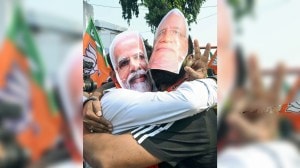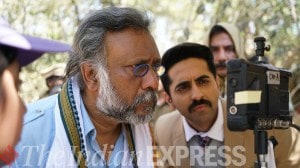Sindhudurg, the Maratha fort that cemented Shivaji Maharaj’s naval dominance
The 35-foot statue of Chhatrapati Shivaji Maharaj in Malvan that collapsed recently was built less than a year ago. In contrast, the Sindhudurg Fort, which Shivaji Maharaj built 357 years ago, still stands strong. The fort is a proud symbol of the Maratha Navy, and the technology behind its construction.
 The construction of Sindhudurg fort was crucial for Shivaji Maharaj, who ensured its success by involving several key officers. (Edited by Abhishek Mitra)
The construction of Sindhudurg fort was crucial for Shivaji Maharaj, who ensured its success by involving several key officers. (Edited by Abhishek Mitra)Written by Shamika Sarvankar
On December 4 2023, a 35-foot statue of Chhatrapati Shivaji Maharaj was unveiled by Prime Minister Narendra Modi at Rajkot Fort in Malvan in Sindhudurg district. In less than a year, on August 26, 2024, the statue collapsed, triggering widespread protests and criticism, with many expressing disbelief that a statue erected in the 21st century, equipped with modern technology, could not survive even a year. Ironically, the Sindhudurg Fort, which Shivaji Maharaj built 357 years ago, still stands strong. This stark contrast has reignited interest in exploring the history of the fort, a proud symbol of the Maratha Navy, and the technology behind its construction.
The dominance of Siddis and pirates
Bakhar — a form of historical narrative written in Marathi prose and regarded as an essential component of mediaeval Indian historiography — provides insights into the construction of Sindhudurg Fort.
In 1510, the Portuguese captured Goa from the Bijapur forces, establishing their dominance along the southern Konkan coastline. This weakened Adil Shahi’s influence in the region, while the borders of Hindavi Swarajya began expanding into Konkan. The seas of Konkan, however, were dominated by Siddis and their pirates, along with the English, Dutch, Portuguese, and French. Siddis are an ethnic minority group inhabiting India and Pakistan, and are descendants of the Bantu population of Africa. These foreign powers possessed superior naval technology and weaponry, making the region highly contested.
Realising the importance of maritime trade for strengthening his kingdom’s economy, Shivaji Maharaj envisioned the creation of a naval force. Known for his strategic brilliance, he used both his military prowess and foresight to overcome his enemies. One of the key elements of his strategy was the creation of a powerful naval fleet, which served not only for defence but also for boosting Swarajya’s economic stability through maritime trade. In January 1664, Shivaji Maharaj plundered the trading hub of Surat, using the wealth acquired to further strengthen his navy and construct sea forts.
Shivaji Maharaj sought to establish his control over the seas, especially against the powerful Siddis, who held the formidable fort of Murud-Janjira. However, despite several attempts, he could not capture Janjira, so he resolved to build a naval fleet and construct a sea fort to counter Siddis’ influence.
Malavan: A strategic location
During an expedition to the Malvan region, Shivaji Maharaj saw an island called Kurte. He personally inspected the site with the help of local fishermen and decided to build Swarajya’s first sea fort on it. He called upon Hiroji Indulkar, an expert in fort construction, who, along with local fishermen, surveyed the area. After thorough examination, Hiroji confirmed that the site was ideal for constructing a sea fort.
Malvan, historically known as Mahalavan, was an ancient port of significance. Various inscriptions and accounts from foreign travellers highlight Malvan’s importance as a port through different periods. When Shivaji Maharaj surveyed the coastline, he observed the rugged rocks along the shore and realised that only boats and ships with great difficulty could navigate the area through specific routes. This made Malvan an ideal location for controlling maritime access and constructing a fort to defend against potential threats.
The construction of the fort began with rituals and prayers at a place known as Morayacha Dhonda, which still stands on the Malvan coast. After performing Ganesh Puja, Shivaji Maharaj’s boat sailed to Kurte island, where the foundation stone for the fort was laid. Five hundred stonecutters, 200 blacksmiths, 100 Goveans, and 3,000 labourers worked tirelessly for three years to construct the fort. The foundation was built using a mixture of lead and stones, ensuring the structure’s strength and durability.
The construction of the fort, estimated at a cost of one crore hons — hon was a gold coin used as currency during the reign of Shivaji Maharaj in the 17th century — saw contributions from people from all walks of life, including fishermen and naval workers. The construction officially began on November 25, 1664. Records from February 8, 1664 note that 25 ships and three large boats sailed from Malvan to Basrur, showcasing the growing influence of the Maratha Navy. By this period, the Marathas had already established control over nine ports in Konkan. Today, the Indian Navy proudly traces its roots to Shivaji Maharaj.
Maharaj’s supervision
The construction of Sindhudurg fort was crucial for Shivaji Maharaj, who ensured its success by involving several key officers. To prevent any foreign interference, 5,000 Mavlas (Maratha soldiers) were stationed to guard the coast. Shivaji Maharaj wrote a letter to Hiroji Indulkar, giving specific instructions for the fort’s construction and closely monitoring every aspect of the project.
In his letter, Shivaji Maharaj emphasised on the need for precision and careful supervision. He advised Hiroji Indulkar to ensure that workers were managed well and that the foundations were laid on a solid rock with sufficient width. He also warned him of Topikars and Sahakars, urging Hiroji to stay vigilant. The letter detailed how to purify water for construction, how to inspect materials, and the importance of sending daily progress reports without fail. Historian Gajanan Walavalkar later published the letter in his writings on Sindhudurg.
During the construction of the fort, Shivaji Maharaj frequently visited the Konkan region. Despite his imprisonment at Agra and subsequent escape, the construction continued under the supervision of Govind Vishwanath Prabhu. Historical records indicate that the construction was completed on March 29, 1667. The Bakhar by Chitraput celebrates the success of Sindhudurg, describing it as an invincible fort, akin to a sacred Tulsi Vrindavan in a temple, and a treasured jewel in Shivaji Maharaj’s kingdom.
To ensure Sindhudurg remained unconquerable, smaller forts like Padmagad, Sarjekot, and Rajkot were built in close proximity. The fortification of Sindhudurg was serpentine, covering four kilometres and enclosing an area of twenty hectares. The walls stood ten metres high and featured 45 stairways, with facilities for guards and cannon placements. A south-facing statue of Hanuman was placed at the entrance.
This visionary fort remains impregnable even today. However, the recent collapse of a statue erected by the government has sparked widespread outrage, with many criticising the administration and drawing comparisons to Shivaji Maharaj’s foresight and meticulous approach.
References:
Shivlanka Sindhudurg; P.K. Ghanekar, 1976
Sindhudurg: The Pride of Konkan; Ashok Kamat and P.K. Ghanekar, 1985
The Maratha Navy: A Unique Era; Dr. Sachin Pendse, 2017
A History of the Maratha Navy and Merchantships; Dr. B.K. Apte, 1973
Dr. Shamika Sarvankar is senior content writer at Loksatta.com



- 01
- 02
- 03
- 04
- 05



























